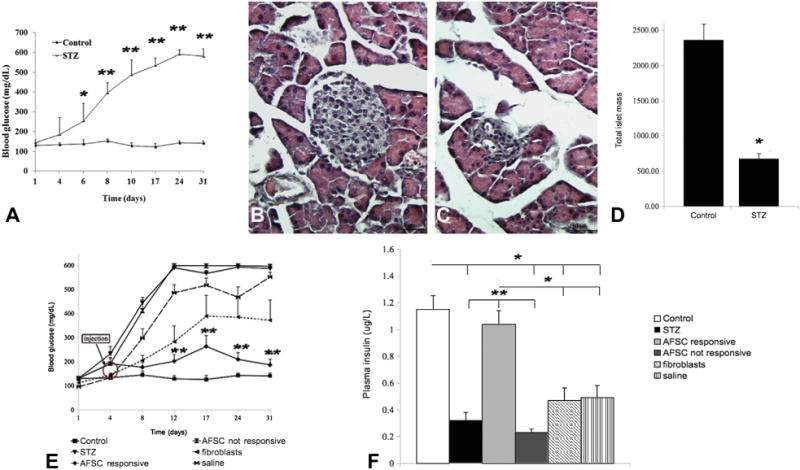Figure 1.

Disease establishment and physiological response to AFSC injection: Establishment of the disease model. Mice receiving multiple low doses of STZ (50 mg/kg for 3 days) developed significant hyperglycemia by experimental day 8. Blood glucose levels remained sustained (600 mg/dL) up to 4 weeks after drug treatment, in contrast to that observed for the healthy control mice that maintained normoglycemia <200 mg/dL (A). STZ-treated mice showed strong islet mass reduction compared with healthy control mice, as revealed by hematoxylin and eosin staining (B,C). Quantification of total islet mass confirmed significant reduction of endocrine pancreatic tissue in diabetic mice 4 weeks after treatment (D). The physiological response of STZ-treated mice to AFSC transplantation was evaluated by detection of blood glucose levels for 4 weeks after AFSC injection and plasma insulin. AFSC-responsive mice displayed normoglycemic average value (<200 mg/dL) 4 weeks after cell injection, similar to that in healthy control mice and significantly lower than that observed in STZ-treated mice (~600 mg/dL). Both fibroblast and saline injections did not prevent development of hyperglycemia, with values ~400 mg/dL and ~550 mg/dL, respectively. A group of AFSC-injected mice did not respond to cell treatment (E, arrow: injected cells). Plasma insulin was quantified 4 weeks after cell treatment. AFSC-responsive mice presented a significantly higher level of circulating insulin compared with AFSC–non-responsive, STZ-treated and fibroblast-injected and saline-injected mice, which all conversely presented significantly reduced amounts of plasma insulin compared with the healthy control group (F). Magnification × 200. Scale bar =50 μm. *P < 0.05, **P < 0.01.
